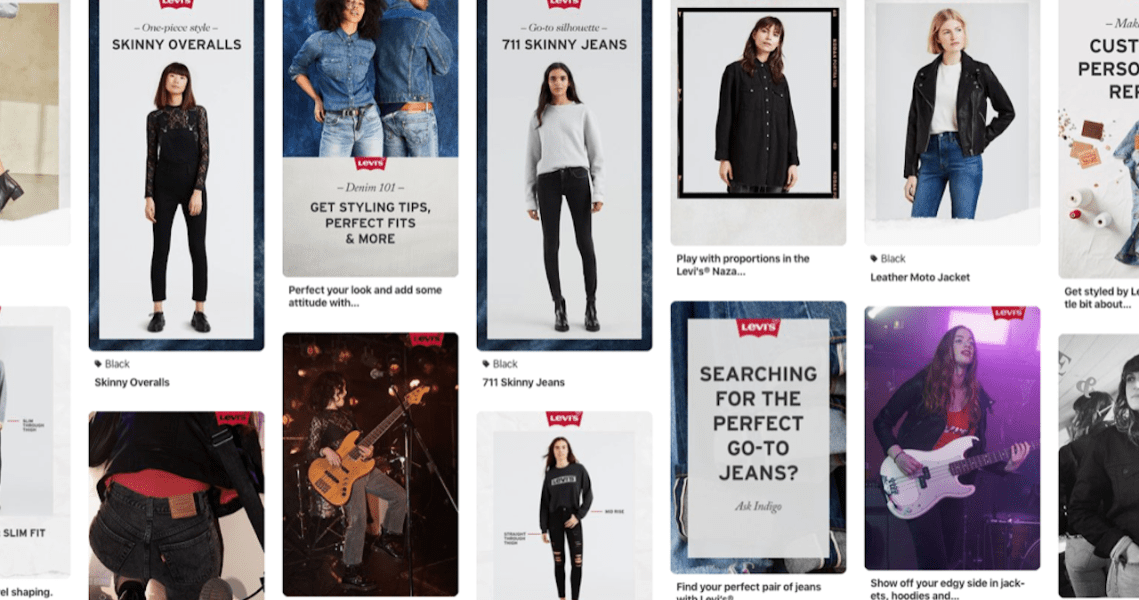Pinterest’s first test as a personal styling tool is with a first-of-its-kind partnership with Levi’s. “Styled by Levi’s” uses Pinterest data to create personalized Pinterest boards for Levi’s customers.
The feature is promoted on Pinterest and is accessible on a Levi’s microsite. Customers select five favorites from a variety of images, then grant access to Levi’s and Pinterest to generate a custom Pinterest board based on their responses and previous activity on Pinterest. Recommendations can include stylized editorial images, flat images of single products and pins promoting Levi’s chatbot or its customization division. When applicable, pins link to corresponding purchase pages on the brand’s website.
Levi Strauss & Co.’s Brady Stewart, who leads the company’s digital business in the Americas, said Pinterest was an attractive platform because its users are “engaged in key life moments.” She also emphasized its personalization and visual search capabilities. “In the apparel space, visual search will become increasingly important. It’s about seeing a great outfit and saying, ‘I want to wear that,’” said Stewart, adding that a visual-based questionnaire is ideal, because “people don’t know how to describe personal style, but you know what you are attracted to.”
Questionnaires, especially those including images, have become an increasingly popular digital tool for informing product recommendations for brands such as Stitch Fix (clothing), True & Co. (bras) and Prose (hair care). By piggybacking on a customer’s previous Pinterest behavior, Levi’s can offer a relatively simple but seemingly personalized experience for shoppers — assuming they’re regular Pinterest users — without needing its own backlog of customer data.
Although this is the first fashion brand to leverage Pinterest’s application program interface (API), Burberry created a similar offering with Pinterest in 2016 to promote its new mascara line, and home furnishings brand West Elm introduced something similar in 2017. Pinterest has been gradually building out functions that utilize image recognition.
In October, Pinterest head of shopping product Tim Weingarten declared an intent to position Pinterest as a personal stylist, partly with the addition of shopping recommendations that find items similar to the pin a user is viewing.
Although image recognition (software that is able to recognize items in images) and visual search (meaning either using an image to conduct a search query or a search query that returns images) require complex technologies, they offer opportunities for digital retailers to create seemingly simple shopping experiences that can feel more natural than text-based searches.
“Because everything’s visual,” Weingarten wrote in the October announcement, “it’s easy to spot things that match your unique tastes, even when you don’t have the words to describe what you’re searching for.”
And that is where the “personal styling” element comes in, said Pinterest creative strategy lead Raashi Rosenberger. “We are looking to take advantage of all the aspirational images that people have saved and use that as a way to make it more actionable.” The Styled by Levi’s tool, she said, helps make discovery a more personalized experience.
“Consumers have endless choices and access to products. At a certain point, that gets almost too big, so you need something more curated; you need someone who will be your virtual stylist and come back with what works for you,” said Stewart, of Levi’s. “This is bringing back the concept of discoverability. Before the internet, you’d go to your favorite boutique and someone pulled the best items for you.”
Early results from the project show that shoppers are especially keen on “creating a direct, one-on-one, personal conversation,” Stewart said, with about half of the traffic and engagement coming from two pins: one that promotes Levi’s customization option and one that links to “Ask Indigo,” which is a chatbot. (The third-most popular category is women’s casual apparel.)
Engagement is about evenly split between men and women, and in the first few weeks, Levi’s had created “thousands” of boards. Stewart hopes that engaging with customers in these ways will encourage loyalty and make them more likely to convert. “We definitely believe that consumers are looking for one-on-one, authentic relationships with brands. Brands that are able to deliver those types of relationships will be more successful in the long run.”




